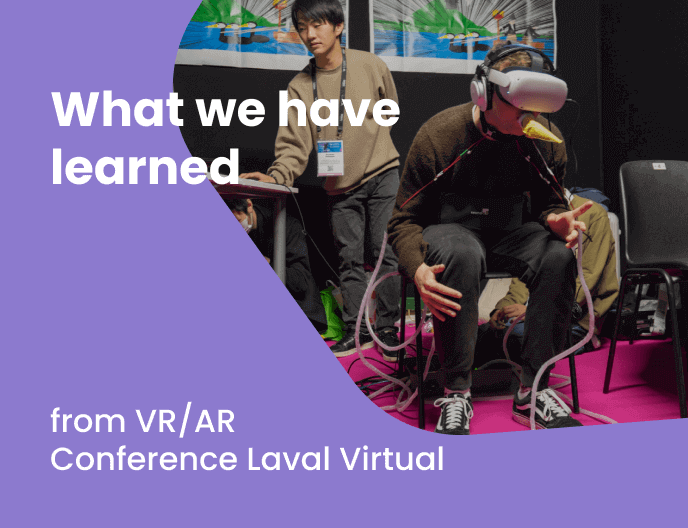What we have learned from the biggest VR/AR Conference Laval Virtual
Written by
Krista Alvarez
Published on
April 23, 2024
Time reading
4 minutes

Now we are ready to share some insights from Laval Virtual, the industry’s largest VR/AR conference. The Laval Virtual Conference, which recently ended, provided an exciting look into the future of VR technology. Here are some of our key takeaways.
In addition to showcasing cool gadgets, the conference highlighted the world-class impact VR/AR can have on society. Sectors such as education, fitness, and humanitarian aid are using these technologies to create programs that have a significant impact. From raising awareness of climate change to helping people in crisis, VR/AR is making a real difference.
Companies are using VR to train and develop the skills of new employees. For example, in the future, we’ll be able to see new hires being trained on complex strategies in a stable simulation environment before going out into the real world. VR will also be able to transport students to historical events and deep waters, providing an engaging learning experience.
We think this conference highlighted the importance of developing best practices for VR/AR programs. Understanding the user experience and developing strong content material is critical to understanding the full capabilities of these technologies. By focusing on comfort and engagement, developers can create new transformative stories.
Laval Virtual’s deep insights beyond the highlights
By the way, this conference is not just about reviewing the latest VR/AR applications. Here are some other findings:
A mature organization The 25th Laval Virtual Conference in 2023 signaled the transition to a more mature VR/AR environment. Although there were fewer audio tools, they went deeper into the main topics and focused more on quality than quantity. Moral worries about the development and application of these technologies became a major topic of discussion.
Social Virtual Realities
Social VR has played an important role in cyberspace as people interact with and become part of others. The discussions explored how VR can create exciting social stories and allow people to connect and collaborate across physical distances. Think about visiting someone’s house from the comfort of your own home (with a VR headset, of course), or working on a project with colleagues from all over the world.
Industry Awareness
The conference brought together a wide range of people from the automotive, education, medical, manufacturing, gaming, and humanities industries to showcase various applications of VR/AR. Technology and knowledge.
Missed opportunities
The conference also identified areas where VR/AR organizations would like to see development. One of them is where projects are an organizational need but no strong software program answer.
New developments
Virtual conferences, events, multiplayer video games, and immersive training simulations. They were identified as key boom areas for VR/AR.
Advances in hardware will drive mass adoption Advances in VR/AR hardware were recognized at the Laval Virtual as a key factor in wider character adoption As VR/AR becomes more comfortable, affordable, and powerful, VR/AR experiences will become more accessible to a growing audience.
AR Theory
While VR seems to have an important position in the meantime, AR has even more superpowers:
Collaboration between companies in the AR space is a common challenge, which demonstrates the need for a more unified approach to improvement and implementation.
State of the Market
The event also provided a snapshot of the current state of the VR/AR market:
- “People with nothing”. This humorous term refers to organizations and people in the early stages of development, without a proper product or vision. As a result, the VR/AR market is still in its early stages, and many players have not even begun to define the problem.
This highlights the importance of combining technical know-how with a strong knowledge of market needs.
- “People with business needs but no technical answers”. This highlights the skill sets we offer by providing software development solutions to companies with VR/AR ideas.
VR technology is on the edge of becoming old-fashioned
At the conference, we learned that the rapid pace of technological innovation means that many VR technologies are becoming outdated. This underscores the need to keep up with new trends to promote future-proof solutions. Also, there is a lot of skepticism about Vision Pro (EU Focus), a very new technology. This suggests that few developers are taking a wait-and-see approach while the technology matures.
Conclusion
By joining Laval Virtual and gaining this valuable knowledge, you can have a significant picture of the VR/AR world. We hope, that our expertise will help you build bridges between corporate dreams and the latest technological answers, and stay ahead of emerging development and hardware trends.